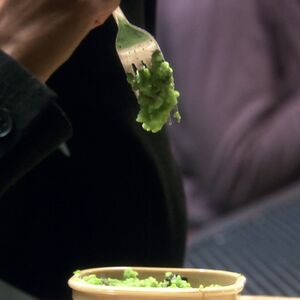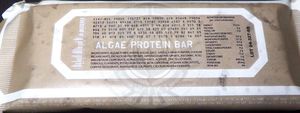Substances in the Re-imagined Series
More actions
| An article from |
The various chemicals, elements and other substances found in the Re-imagined Series vary from the familiar to the outright strange.
The Fleet's Eats
editColonial technology is sufficiently advanced to allow battlestars to work almost autonomously for years, but for the motley of stranded civilian ships that form Galactica's charge, the matter of food and drink for nearly 50,000 humans while migrating through interstellar space is a very serious matter.
It was through a matter of good fortune that the Fleet comprises of many ships that provide the raw materials needed for generating food products. Most of these ships were freighters that were making their routine commercial runs between Colonial ports-of-call, much like America's interstate trucking system delivers goods between cities. Some ships, such as the Kimba Huta, carried actual foodstuffs such as meat. Others, such as Galactica and the Celestra were built for long-term spacefaring. Most of the other ships of the Fleet, like the Virgon Express, were never designed for long-term flight and are missing the basics needed for extended flight. In particular, food and drink must be provided for through other means.
In "Water," Dr. Gaius Baltar notes the amount of consumables he estimates that the Fleet's citizens require each week:
"The current civilian population of 45,265 will require, at minimum, 82 tons of grain, 85 tons of meat, 119 tons of fruit, 304 tons of vegetables and ... 2.5 million jps of water."
Water
editAs stated in the episode "Water," Galactica has the ability to recycle almost all of its water supply. However, it must tank off water to ships which cannot recycle as efficiently.
Dr. Baltar uses the term "JP" as a unit of liquid volume for water [1]. However, this unit of measure is not further defined. If Baltar's estimation of water units per week is divided by the population count, the result is:
2500000/45265 = 55.2303
This is the number of JPs needed at minimum per survivor per week. Dividing this number by 7 (assuming that the Colonial week has seven days as it does on Earth, given no other official reference that can be used):
55.2303/7 = 7.9 JPs per colonist per day
A minimum average of 1 gallon, or approximately 4 liters or 8 pints, is needed for a typical human. As water is also used for personal hygiene, cleaning, and shipboard functions related to cooling or heating a spacecraft per person, the unit of JPs, if approximated as pints, means that Dr. Baltar's numbers are realistic: Each Colonial requires 8 or so pints of water per day.
The matter of water consumption for ships that cannot recycle is still a question not answered in the series. Galactica is fortunate to find a planet containing water to refill its stores, and it is logical that the Fleet takes in as much water as it can reasonably carry to all ships. However, waste will still occur. The only way that the Fleet can manage to stay space-borne is to "close the loop," or recycle the water that cannot normally be recycled. When Pegasus was in the Fleet, this process might have been easier if other Fleet ships are able to tank off their waste water to either of the two battlestars, then tank up with potable water as the battlestar's recycling abilities refreshed the waste water.
Food
editDr. Baltar uses "tons" to measure out the amount of food required per colonist.
As noted in "The Farm," the Fleet has ships that carry frozen food that was intended for export to other cities or colonies.
In the episode "The Passage" more information is given on how the Fleet feeds itself. The Colonials suffer another supply shortage. The Fleet's raw food storage has been contaminated in some way. Based on dialogue, there is a primary "good food" storage and a recycled storage where it is reprocessed for use. The episode's writer, Jane Espenson, notes that, in an draft of the script, the Fleet's meat was generated from cloning[2].
Food is measured in energy by calories (technically, kilocalories) on the real-world Earth. Battlestar Galactica has not provided any counterpart to this unit of measure, nor is there any indication as to the type of foodstuffs generated by the Fleet's food system--that is, the "nutrition facts" for the food in carbohydrates, proteins, fats, and vitamins. For now, it is impossible to determine how effective the Fleet's food system is in keeping everyone sufficiently fed.
Algae
edit
After a harrowing trek through a dangerous star cluster, the Fleet finds a planet containing algae that can be reconstituted into food. Dr. Cottle noted that the algae, while tough to digest, was also almost pure protein. For the most part, this should satisfy the nutritional needs, as the human body can also convert most proteins into the body's fuel, carbohydrates, thanks to other organs in the body. This same process is also what happens when your body has too little energy: in a starvation state, the body will break down its own muscle tissue into fuel.
One possible natural algae that could have been found on the algae planet is spirulina, which is rich in protein.

After obtaining enough algae from the planet, the Fleet is able to turn it into various foodstuffs: algae mash, algae crackers, and algae protein bars. However, some in the Fleet, like Nicholas Tyrol, are allergic to the mash and an alternate food source is alluded to (TRS: "The Ties That Bind"). Other non-algae food stores still exist, given the presence of coffee and fruits, such as apples, are available for consumption following the events of the Battle of the Ionian Nebula (TRS: "Six of One").
The Tylium Question
editTylium is a curious substance in the universe where the Twelve Colonies resides. Used by both Colonials and Cylons, tylium has the properties of a mineral or fossil fuel in that the substance is mined and refined. Like some fossil fuels, tylium isn't useable until refined. While the ore can't be detonated, its precursor (similar to refined crude oil before its refinement into gasoline and other products) is very explosive. The fuel itself isn't as explosive as precursor, however.
So, is tylium a made-up substance or would it have a counterpart or comparative substance to the elements we know of here on the real-world Earth?
One speculation is that tylium can possibly be similar to Helium-3[3]. Helium-3 is a primordial component in the Earth's crust, is deposited via solar wind on moons and asteroids. But, while helium-3 has potential as an energy source, the amount of energy needed to ignite it (fusion) would be more than the energy it would expel for use as an energy by-product.
There is a problem with this speculation in that helium-3 is a gas, not a mineral or solid element. A tylium counterpart should be a solid, non-radioactive, and likely non-organic substance. Coal would fit the tylium concept were it not a fossil fuel, which would suggest that life forms existed and died on the celestial bodies where the substance is mined. Perhaps another element from the Periodic Table could be a counterpart of tylium.
Tylium could be an exotic primordial compound. Research by astronomers, spectrographic analysis among them, has found compounds which do not normally form on Earth, but are formed and stabilized within the unique conditions of space. Tylium could be one such compound, which would in part explain why the Colonial scouts were looking at asteroid belts rather then planets to find it. Tylium could be a primordial compound that is destabilized on contact with other elements, such as oxygen, that are commonly found on terrestrial worlds.
Tylium is seen as a petroleum-like fuel and as refined ore in the episode "Dirty Hands."
Familiar Elements and Chemicals
editPlutonium is a man-made element used primarily in the cores of nuclear weapons[4]. Gaius Baltar asks for the plutonium from one of the ship's nuclear warheads from Commander Adama to build his Cylon detector (TRS: "Bastille Day"). Baltar also mentions the use of tetrahydrocycline for the detector (TRS: "Water").
The Red Moon's atmosphere is composed mostly of carbon dioxide, methane and argon (TRS: "You Can't Go Home Again"). Oxygen is mentioned several times throughout the series.
Chief Tyrol asks for copper tubing when some his deckhands fail to build a proper distiller (TRS: "Litmus").
On Galactica, perishable goods are kept in titanium lockers (TRS: "Final Cut").
Chromium is known to the Colonials by this name, since "chrome job" is a slang term for Cylon Centurions (TRS: "Battlestar Galactica: The Resistance").
Drugs
editDoloxan is used in chemotherapy for cancer patients. Laura Roslin chooses to take chamalla extract instead, which does little for her cancer, but grants her remarkable side-effects.
Other drugs such as Vinagro, morpha, stims, and serisone have a logical counterpart to real-world drugs such as Viagra, morphine, stimulants such as amphetamines, or fluid-reduction treatments.
An unnamed drug is administered to Gaius Baltar in order to provoke an intense state of hallucinatory anxiety. This drug had been the property of the Colonial military prior to the fall of the Twelve Colonies (TRS: "Taking a Break From All Your Worries").
References
edit- ↑ In the Season 3 episode "Dirty Hands," Baltar describes the culture of Aerilon as "going down to the pub for a pint," suggesting that Colonials also use the unit "pint." The term may also be intended to reflect Aerelon's culture as comparable to that of working-class Ireland, Scotland or Northern England.
- ↑ "Jane Espenson on post-The Passage questions," TV Squad, weblog, December 11, 2006.
- ↑ See Wikipedia's article on Helium-3 and this article by a private firm on the concept.
- ↑ The existence of this synthetic element means that the natural element it is derived from, uranium, exists in the world of the Re-imagined Series. (Etymological purists on the origins of the names of the Lords of Kobol may be annoyed that the Greek pantheon parallelism to the Lords of Kobol is disturbed again, for plutonium is named for Pluto, the Roman counterpart of the Greek god Hades).
